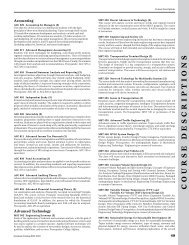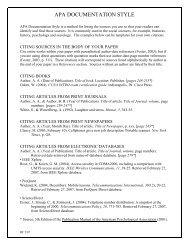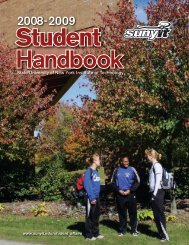Expanding the Public Sphere through Computer ... - ResearchGate
Expanding the Public Sphere through Computer ... - ResearchGate
Expanding the Public Sphere through Computer ... - ResearchGate
You also want an ePaper? Increase the reach of your titles
YUMPU automatically turns print PDFs into web optimized ePapers that Google loves.
CHAPTER 6. ANALYZING THE TALK.ABORTION NEWSGROUP 88<br />
a lower spread value. As can be seen from Table 6.3, <strong>the</strong> median spread of <strong>the</strong><br />
very frequent author is 363 days, essentially <strong>the</strong> entire year. It is only slightly<br />
less for <strong>the</strong> frequent authors, and drops considerably for <strong>the</strong> occasional and infrequent<br />
authors. However, even among <strong>the</strong> infrequent authors, <strong>the</strong> median spread is<br />
still greater than 120 days, or about 4 months time. This indicates a considerable<br />
breadth of participation, as measured by time, among all of <strong>the</strong> most frequently<br />
contributing authors.<br />
Third, <strong>the</strong> number of different days on which authors contributed messages can be<br />
analyzed. With this measure, ten days spread over six months is not differentiated<br />
from ten days spread over two weeks. Thus, <strong>the</strong> number of days is an indicator<br />
of intensity of commitment. Days, by definition, is equal to or less than spread<br />
and messages (an author could not have contributed 10 messages on 11 different<br />
days). When examining days, much more dramatic differences between <strong>the</strong> very<br />
frequent authors and <strong>the</strong> o<strong>the</strong>r types of authors emerge. The median number of<br />
days on which very frequent authors wrote messages was more than three times<br />
greater than <strong>the</strong> median number of days for <strong>the</strong> frequent authors. The medians of<br />
<strong>the</strong> occasional and infrequent authors decline by about half as we move down <strong>the</strong><br />
scale. This measure indicates that intensity of participation is strongly correlated<br />
with frequency of participation. This finding is fur<strong>the</strong>r supported by examining<br />
<strong>the</strong> ratio of messages to days across different author groups. A larger ratio of messages<br />
to days indicates a more intensive commitment to <strong>the</strong> group than a smaller<br />
ratio. As shown in Table 6.4 on <strong>the</strong> page before, very frequent authors wrote an<br />
average of 7.64 messages on every day <strong>the</strong>y participated. At <strong>the</strong> same time, we<br />
should note that down to <strong>the</strong> infrequent authors, participants averaged about two<br />
posts for each day of participating.<br />
The distribution of messages by threads offers a second mode of assessing <strong>the</strong><br />
behaviors of <strong>the</strong> participants. As discussed above, <strong>the</strong> nearly 46,000 messages<br />
posted to <strong>the</strong> group found <strong>the</strong>ir way into nearly 8,500 different threads. As discussed<br />
in Section 3.3 on page 51, every message contains a subject heading, which<br />
permits organization of <strong>the</strong> newsgroup by thread. Authors who are following up<br />
or replying to ano<strong>the</strong>r message frequently will post a message in <strong>the</strong> same thread.<br />
This is to ease <strong>the</strong> reading of <strong>the</strong> newsgroup, as most newsreading software allows<br />
<strong>the</strong> user to select for reading only those articles matching indicating threads. In<br />
o<strong>the</strong>r words, threads serve as cues to o<strong>the</strong>r readers that a message is “related” to<br />
previous messages in <strong>the</strong> same thread. A thread can be viewed as miniature conversation<br />
among <strong>the</strong> participating authors, and <strong>the</strong> newsgroup can be considered<br />
to have as many simultaneous conversations as <strong>the</strong>re are simultaneous threads.
















